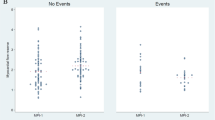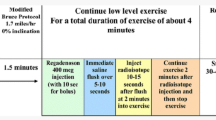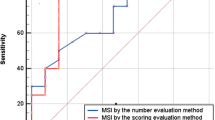Abstract
Background
The prognostic value of single-photon emission computed tomography myocardial perfusion imaging (MPI) is well established. There is a paucity of data on the prognostic value of changes in perfusion defect size (PDS) on serial MPIs.
Methods
From the MPI database at the University of Alabama at Birmingham, consecutive patients who underwent two regadenoson stress MPIs between July 2008 and March 2013 were identified. The MPIs were analyzed side-by-side using an automated software program for presence and change in PDS. Improvement in PDS was defined as a reduction ≥5% of left ventricle. A drop in left ventricular ejection fraction (LVEF) was defined as a decrease ≥5%. The primary outcome was a composite of death, myocardial infarction (MI), and coronary revascularization (CR).
Results
There were 698 patients (61 ± 11 years, 53% male, 48% diabetes, 25% prior MI, 49% prior CR) who underwent two regadenoson MPIs within 16 ± 9 months for clinical indications. The primary outcome occurred in 167 (24%) patients (8% death, 9% MI, 15% CR) during 24 ± 16 months of follow-up after the second MPI. The MPIs were normal in both studies in 399 (57%, Group 1), showed improvement in 94 (14%, Group 2, PDS 15% ± 16% vs 28% ± 18%, P < .001) and no change or worsening in 205 patients (29%, Group 3, 28% ± 17% vs 20% ± 17%, P < .001). The best outcomes were seen in Group 1 and the worst in Group 3 (log-rank P < .001). Similar trends were seen for the components of the primary outcome (P = .04 for death, P < .001 for MI, P < .001 for CR). In a Cox-regression model that adjusted for baseline factors including PDS and LVEF on initial MPI, the hazard ratios for primary outcome were 2.0 (P = .02) and 3.9 (P < .001) for Groups 2 and 3 compared to Group 1, respectively. In addition, an LVEF drop ≥5% was independently associated with the primary outcome (HR 1.5, P = .01).
Conclusion
Changes in PDS and LVEF on serial MPIs provide incremental prognostic information to initial and follow-up MPI findings. Lack of improvement or an increase in PDS and a drop in LVEF identify high-risk patients.



Similar content being viewed by others
Abbreviations
- CI:
-
Confidence intervals
- CR:
-
Coronary revascularization
- HR:
-
Hazard ratio
- LVEF:
-
Left ventricular ejection fraction
- MI:
-
Myocardial infarction
- MPI:
-
Myocardial perfusion imaging
- MT:
-
Medical therapy
- PCI:
-
Percutaneous coronary intervention
- PDS:
-
Perfusion defect size
References
Shaw LJ, Hage FG, Berman DS, Hachamovitch R, Iskandrian A. Prognosis in the era of comparative effectiveness research: Where is nuclear cardiology now and where should it be? J Nucl Cardiol 2012;19:1026-43.
Iqbal FM, Hage FG, Ahmed A, Dean PJ, Raslan S, Heo J, et al. Comparison of the prognostic value of normal regadenoson with normal adenosine myocardial perfusion imaging with propensity score matching. JACC 2012;5:1014-21.
Hage FG, Ghimire G, Lester D, McKay J, Bleich S, El-Hajj S, et al. The prognostic value of regadenoson myocardial perfusion imaging. J Nucl Cardiol 2015;. doi:10.1007/s12350-014-0050-y.
Dakik HA, Kleiman NS, Farmer JA, He ZX, Wendt JA, Pratt CM, et al. Intensive medical therapy versus coronary angioplasty for suppression of myocardial ischemia in survivors of acute myocardial infarction: A prospective, randomized pilot study. Circulation 1998;98:2017-23.
Berman DS, Kang X, Schisterman EF, Gerlach J, Kavanagh PB, Areeda JS, et al. Serial changes on quantitative myocardial perfusion SPECT in patients undergoing revascularization or conservative therapy. J Nucl Cardiol 2001;8:428-37.
Taillefer R, Ahlberg AW, Masood Y, White CM, Lamargese I, Mather JF, et al. Acute beta-blockade reduces the extent and severity of myocardial perfusion defects with dipyridamole Tc-99m sestamibi SPECT imaging. J Am Coll Cardiol 2003;42:1475-83.
Schwartz RG, Pearson TA, Kalaria VG, Mackin ML, Williford DJ, Awasthi A, et al. Prospective serial evaluation of myocardial perfusion and lipids during the first six months of pravastatin therapy: Coronary artery disease regression single photon emission computed tomography monitoring trial. J Am Coll Cardiol 2003;42:600-10.
Mahmarian JJ, Dakik HA, Filipchuk NG, Shaw LJ, Iskander SS, Ruddy TD, et al. An initial strategy of intensive medical therapy is comparable to that of coronary revascularization for suppression of scintigraphic ischemia in high-risk but stable survivors of acute myocardial infarction. J Am Coll Cardiol 2006;48:2458-67.
Shaw LJ, Berman DS, Maron DJ, Mancini GB, Hayes SW, Hartigan PM, et al. Optimal medical therapy with or without percutaneous coronary intervention to reduce ischemic burden: Results from the Clinical Outcomes Utilizing Revascularization and Aggressive Drug Evaluation (COURAGE) trial nuclear substudy. Circulation 2008;117:1283-91.
Venkataraman R, Belardinelli L, Blackburn B, Heo J, Iskandrian AE. A study of the effects of ranolazine using automated quantitative analysis of serial myocardial perfusion images. JACC 2009;2:1301-9.
Iskandrian AE, Hage FG, Shaw LJ, Mahmarian JJ, Berman DS. Serial myocardial perfusion imaging: Defining a significant change and targeting management decisions. JACC Cardiovasc Imaging 2014;7:79-96.
Thygesen K, Alpert JS, Jaffe AS, Simoons ML, Chaitman BR, White HD, et al. Third universal definition of myocardial infarction. Circulation 2012;126:2020-35.
Grundy SM, Cleeman JI, Merz CN, Brewer HB Jr, Clark LT, Hunninghake DB, et al. Implications of recent clinical trials for the National Cholesterol Education Program Adult Treatment Panel III guidelines. Circulation 2004;110:227-39.
Henzlova MJ, Cerqueira MD, Mahmarian JJ, Yao SS, Quality Assurance Committee of the American Society of Nuclear C. Stress protocols and tracers. J Nucl Cardiol 2006;13:e80-90.
Iqbal FM, Al Jaroudi W, Sanam K, Sweeney A, Heo J, Iskandrian AE, et al. Reclassification of cardiovascular risk in patients with normal myocardial perfusion imaging using heart rate response to vasodilator stress. Am J Cardiol 2013;111:190-5.
Al Jaroudi W, Iskandrian AE. Regadenoson: A new myocardial stress agent. J Am Coll Cardiol 2009;54:1123-30.
Ficaro EP, Lee BC, Kritzman JN, Corbett JR. Corridor4DM: The Michigan method for quantitative nuclear cardiology. J Nucl Cardiol 2007;14:455-65.
Germano G, Kiat H, Kavanagh PB, Moriel M, Mazzanti M, Su HT, et al. Automatic quantification of ejection fraction from gated myocardial perfusion SPECT. J Nucl Med 1995;36:2138-47.
AlJaroudi W, Alraies MC, Hachamovitch R, Jaber WA, Brunken R, Cerqueira MD, et al. Association of left ventricular mechanical dyssynchrony with survival benefit from revascularization: A study of gated positron emission tomography in patients with ischemic LV dysfunction and narrow QRS. Eur J Nucl Med Mol Imaging 2012;39:1581-91.
Hage FG, Dean P, Iqbal F, Heo J, Iskandrian AE. A blunted heart rate response to regadenoson is an independent prognostic indicator in patients undergoing myocardial perfusion imaging. J Nucl Cardiol 2011;18:1086-94.
Rozanski A, Gransar H, Hayes SW, Min J, Friedman JD, Thomson LE, et al. Temporal trends in the frequency of inducible myocardial ischemia during cardiac stress testing: 1991 to 2009. J Am Coll Cardiol 2013;61:1054-65.
Iskandrian AE, Hage FG. Declining frequency of ischemia detection using stress myocardial perfusion imaging. J Am Coll Cardiol 2013;61:1066-8.
Ronan G, Wolk MJ, Bailey SR, Doherty JU, Douglas PS, Hendel RC, et al. ACCF/AHA/ASE/ASNC/HFSA/HRS/SCAI/SCCT/SCMR/STS 2013 multimodality appropriate use criteria for the detection and risk assessment of stable ischemic heart disease: A report of the American College of Cardiology Foundation Appropriate Use Criteria Task Force, American Heart Association, American Society of Echocardiography, American Society of Nuclear Cardiology, Heart Failure Society of America, Heart Rhythm Society, Society for Cardiovascular Angiography and Interventions, Society of Cardiovascular Computed Tomography, Society for Cardiovascular Magnetic Resonance, and Society of Thoracic Surgeons. J Nucl Cardiol 2014;21:192-220.
Mahmarian JJ, Cerqueira MD, Iskandrian AE, Bateman TM, Thomas GS, Hendel RC, et al. Regadenoson induces comparable left ventricular perfusion defects as adenosine: A quantitative analysis from the ADVANCE MPI 2 trial. JACC Cardiovasc Imaging 2009;2:959-68.
Farzaneh-Far A, Phillips HR, Shaw LK, Starr AZ, Fiuzat M, O’Connor CM, et al. Ischemia change in stable coronary artery disease is an independent predictor of death and myocardial infarction. JACC Cardiovasc Imaging 2012;5:715-24.
Elhendy A, Schinkel AF, van Domburg RT, Bax JJ, Valkema R, Poldermans D. Risk stratification of patients after myocardial revascularization by stress Tc-99m tetrofosmin myocardial perfusion tomography. J Nucl Cardiol 2003;10:615-22.
Zhang X, Liu X, He ZX, Shi R, Yang M, Gao R, et al. Long-term prognostic value of exercise 99mTc-MIBI SPET myocardial perfusion imaging in patients after percutaneous coronary intervention. Eur J Nucl Med Mol Imaging 2004;31:655-62.
Georgoulias P, Demakopoulos N, Tzavara C, Giannakou S, Valotassiou V, Tsougos I, et al. Long-term prognostic value of Tc-99m tetrofosmin myocardial gated-SPECT imaging in asymptomatic patients after percutaneous coronary intervention. Clin Nucl Med 2008;33:743-7.
Cottin Y, Rezaizadeh K, Touzery C, Barillot I, Zeller M, Prevot S, et al. Long-term prognostic value of 201Tl single-photon emission computed tomographic myocardial perfusion imaging after coronary stenting. Am Heart J 2001;141:999-1006.
Rajagopal V, Gurm HS, Brunken RC, Pothier CE, Bhatt DL, Lauer MS. Prediction of death or myocardial infarction by exercise single photon emission computed tomography perfusion scintigraphy in patients who have had recent coronary artery stenting. Am Heart J 2005;149:534-40.
Shaw LJ, Cerqueira MD, Brooks MM, Althouse AD, Sansing VV, Beller GA, et al. Impact of left ventricular function and the extent of ischemia and scar by stress myocardial perfusion imaging on prognosis and therapeutic risk reduction in diabetic patients with coronary artery disease: results from the Bypass Angioplasty Revascularization Investigation 2 Diabetes (BARI 2D) trial. J Nucl Cardiol 2012;19:658-69.
Disclosures
Drs. Hage and Iskandrian have received research grants from Astellas Pharma USA.
Author information
Authors and Affiliations
Corresponding author
Additional information
See related editorial, doi:10.1007/s12350-015-0171-y.
Stephanie El-Hajj and Wael A. AlJaroudi have contributed equally to this study.
All editorial decisions for this article, including selection of reviewers and the final decision, were made by guest editor Alberto Cuocolo, MD.
Funding
None.
Rights and permissions
About this article
Cite this article
El-Hajj, S., AlJaroudi, W.A., Farag, A. et al. Effect of changes in perfusion defect size during serial regadenoson myocardial perfusion imaging on cardiovascular outcomes in high-risk patients. J. Nucl. Cardiol. 23, 101–112 (2016). https://doi.org/10.1007/s12350-015-0174-8
Received:
Accepted:
Published:
Issue Date:
DOI: https://doi.org/10.1007/s12350-015-0174-8




